20 Sep 2013 | News and features
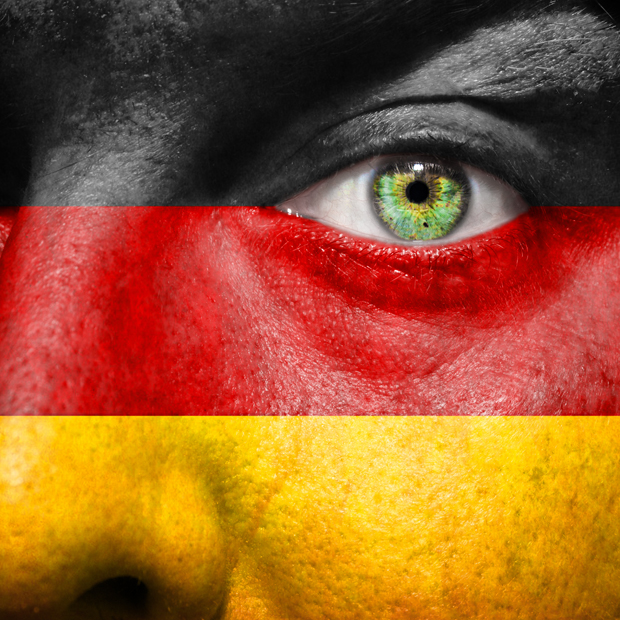
(Photo illustration: Shutterstock)
Freedom of expression is protected by the German Constitution and basic laws. There is room for improvement, with Germany’s hate speech and libel laws being particularly severe.
Germany’s biggest limits on freedom of expression are due to its strict hate speech legislation which criminalises incitement to violence or hatred. Germany has particularly strict laws on the promotion or glorification of Nazism, or Holocaust denial with paragraph 130(3) of the German Criminal Code stipulating that those who ‘publicly or in an assembly approve, deny, or trivialise’ the Holocaust are liable to up to five years in prison or a fine. Hate speech also extends to insulting segments of the population or a national, racial or religious group, or one characterised by its ethnic customs.
Germany still has strict provisions in the criminal code providing penalties for defamation of the President, insulting the Federal Republic, its states, the flag, and the national anthem. However, in 2000, the Federal Constitutional Court stated that even harsh political criticism, however unjust, does not constitute insulting the Republic.
Freedom of religious expression is compromised through anti-blasphemy laws criminalising ‘offences related to religion and ideology’. Paragraph 166 of the Criminal Code prohibits defamation against ‘a church or other religious or ideological association within Germany, or their institutions or customs’. While very few people (just 10) have been convicted under the blasphemy legislation since 1969, the impact of hate speech legislation is seen more frequently, in particular in the prosecution of religious offences. In 2006, a pensioner in the state of North Rhine-Westphalia was given a 1-year suspended sentence for printing ‘The Koran, the Holy Koran’ on toilet paper, and sending it to 22 Mosques and Muslim community centres. In 2011, nine of the 18 operators of the far right online radio programme ‘Resistance Radio’ were given between 21 months and three years in prison for inciting hatred.
Germany has also seen heated debate over a widespread ban on religious symbols in public workplaces, especially affecting Muslim women who wear headscarves.
Half of Germany’s 16 states have, to various extents, banned teachers and civil servants from wearing religious symbols at work. Yet this is not applied equally to all religions; five states have made exceptions for Christian religious symbols.
Media freedom
Government and political interference in the media sector continues to raise concerns for media independence, with several incidents of interventions by politicians attempting to influence editorial policy. In 2009, chief editor of public service broadcaster ZDF, Nikolaus Brender saw his contract terminated by a board featuring several politicians from the ruling Christian Democratic Union. Reporters Without Borders labelled it a ‘blatant violation of the principle of independence of public broadcasters.’ In 2011, the editor of Bild, the country’s biggest newspaper, received a voicemail message from President Christian Wulff, who threatened ‘war’ on the tabloid which reported on unusual personal loan he received.
Media plurality is strong among regional newspapers though due to financial pressure, media plurality declined in 2009 and 2010. Germany has one of the most concentrated TV markets in Europe, with 82% of total TV advertising spend shared among just two main TV stations in Germany. This gives a significant amount of influence to just 2 broadcasters and the majority of Germans still receive their daily news from the television.
The legal framework for the media is generally positive with accessible public interest defences for journalists in the law of privacy and defamation. However, Germany still has criminal provisions in its defamation law, which although unused, remain in the penal code. Germany’s civil defamation law is medium to low cost in comparison with other European jurisdictions, places the burden of proof on the claimant (a protection to freedom of expression) and contains a responsible journalism defence, although not a broader public interest defence.
Digital
The digital sphere in Germany has remained relatively free with judicial oversight over content takedown, protections for online privacy and a high level of internet penetration (83% of Germans are online). Germany’s Federal Court of Justice has ruled that access to the internet is a basic right in modern society. Section 184b of the German Penal Code ‘states that it is a criminal offense to disseminate, publicly display, present or otherwise make accessible any pornographic material showing sexual activities performed by, on or in the presence of a child.’ Germany has also ratified and put into the law the Council of Europe’s Convention on Cyber Crimes from 2001. Mobile operators also signed up to a Code of Conduct in 2005, which includes a commitment to a dual system of identification and authentication to protect children from harmful content. This was reaffirmed and made binding in 2007.
There are concerns over the increased use of surveillance of online communications, especially since a new antiterrorism law took effect in 2009.
In 2011, German authorities acquired the license for a type of spyware called FinSpy, produced by the British Gamma Group. This spyware can bypass anti-virus software and can extract data from the device it is targeting. Two reports by the German Parliamentary Control Panel, from 2009 and 2010, stated that several German intelligence units had monitored emails with the amount of surveillance increasing from 7 million pieces items in 2009 to 37 million in 2010. However, Germany’s Constitutional Court ruled in February that intelligence agencies are only allowed to collect data secretly from suspects’ computers if there is evidence that human lives or state property are in danger and the authorities must get a court order before they secretly upload spyware to a suspect’s computer.
Germany’s tough hate speech legislation also chills free speech online. In January 2012, Twitter adopted a new global policy allowing the company to delete tweets if countries request it, meaning that tweets become subject to Germany’s hate speech laws. The latest Twitter transparency report states that German government agencies asked for just 2 items to be removed. In October 2012, Twitter also blocked the account of a far-right group, Better Hannover, after a police investigation.
Artistic freedom
Artists can work relatively freely in Germany. Freedom of expression in arts is protected under the Constitution, and is largely respected, especially for satire or comedy. Yet, the freedom of expression of artists is chilled through strict hate speech and blasphemy laws.
The German authorities very rarely use blasphemy laws against artists. However, there have been several examples of art being subjected to censorship due to religious offence. In 2012, at the exhibition ‘Caricatura VI – The Comic Art – analog, digital, international’ in Kassel, a cartoon created by cartoonist Mario Lars was removed after protests that it offended religious sensibilities.
There is persistent sensitivity around artistic works depicting the Nazi period. In April 2013, the German version of an Icelandic author’s book was ‘censored’ by its publisher, who cut 30 chapters from Hallgrímur Helga’s novel, ‘The woman at 1000°’. Key passages about Hitler, concentration camps and SS were censored to fit the German market.
6 Sep 2013 | Australia, Index Reports, News and features, Politics and Society, Religion and Culture
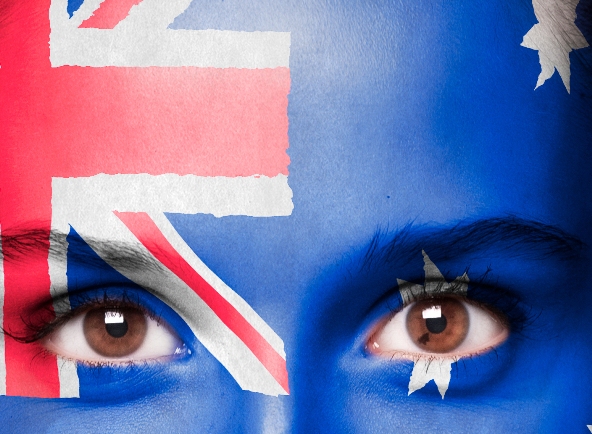
Australia has no grand constitution outlining civil freedoms and national character. The constitution is instead a lengthy, largely legislative document and does not guarantee freedom of speech or press outright. That notwithstanding Australia’s High Court believes that freedom of speech is implied within, however some press watchers believe it could be strengthened.
Despite a relatively free press Reporters Without Borders placed Australia at number 26 in its 2013 Press Freedom Index, up four spots from 2012 but still far behind closest neighbour New Zealand (number eight), as well as Finland, Jamaica and Costa Rica.
Outright press censorship and the highest profile cases of recent years have involved breaches of discrimination acts or incitements to hatred. Meanwhile press laws and reforms to them have been touted with scant success. Widespread internet censorship was defeated last year after Communications Minister Stephen Conroy rescinded the internet filtering scheme after five years trying to pass it.
However though always fearful of harming the children, and causing offence, most Australians see outright censorship measures as neither useful, fair or in keeping with national ideals.
A historical example might be the 1951 referendum on whether to outlaw the Australian Communist Party after Liberal Prime Minister Robert Menzies tried to ban it. Despite fear of the communist threat it was defeated by voters thanks to worries on curbs of freedom of speech and association.
Anti-discrimination laws, hate speech and other things untoward
In 2011 political columnist Andrew Bolt, who works for Murdoch-owned News Corp (Australia’s branch of News Limited), was found to have breached the Racial Discrimination Act in two 2009 articles after he implied lighter-skinned indigenous people identified as aboriginal for gain. Speaking outside court after the ruling he called it “a terrible day for free speech in this country”. He had argued his articles were within the laws of free speech provisions. In 2009 “shock jock” broadcaster Alan Jones was in trouble for breaching anti-discrimination laws for comments made about Lebanese Muslim men years previous. The court found he had incited hatred.
Age columnist Catherine Devenney was also fired after she live-Tweeted during the Logie television awards: “I do so hope Bindi Irwin gets laid” in 2010. Irwin was 13 at the time.
Most recently political organisation GetUp accused Channel Nine, Channel Ten and Channel Seven of censorship after they refused to run political ads attacking Rupert Murdoch and News Corp. Channel Nine did run the ads, albeit briefly, before pulling them and blaming a ‘coding error’ for the original airing.
National Director Sam McLean told Fairfax: “This is censorship, pure and simple. Channel Seven says it’s about taste but I don’t buy that for a second. Channel Ten told us they don’t want to criticise another media network – but this is about Rupert’s son Lachlan being [chairman] of Channel Ten.”
Reforms and laws
In March four media reform bills put forward by Labor under then-Prime Minister Julia Gillard were withdrawn after they couldn’t draw the needed amount of cross-bench support from MPs. All were controversial, with the ability to affect the press and drew considerable opprobrium from some quarters of the industry.
The most controversial, from an industry perspective, was the appointment of a Public Interest Media Advocate (PIMA), a watchdog for self-regulatory industry bodies like the Press Council. Called a “big stick… and de facto form of licensing” by Mark Pearson, a media expert and former Australian correspondent for Reporters Without Borders, and ‘Stalinist’ by News Ltd boss Kim Williams, it would have meant much more bureaucracy
“I find it absolutely breathtaking to be lectured by the Murdoch press about the privacy laws,” committee chairman Doug Cameron, a Labor senator, said in response to criticism by News Ltd boss Kim Williams.
Tony Abbott backed critics, calling it a threat to free speech. However in Parliament he seemed more concerned with the sitting government’s purported attacks on freedom of speech than how such laws might play out longer term. “This is a government which wants to hide the truth to protect itself. They don’t want to protect the national interest; they want to damage the national interest,” he said.
Two reports released this year have also been divisive. The Finklestein Report and Convergence Review looked at media regulation (by the government) and media ownership and diversity issues. The former has been lambasted as a threat to a free press, with national broadsheet the Australian noting that the paper had been compiled by many journalism academics either unused to or out-of-practise when it came to the rigours of day-to-day journalism and thus unreliable to offer advice. A Daily Telegraph front page compared Information Minister Stephen Conroy with famous dictators including Mao and Stalin.
Writing in The Conversation, Associate Professor of Journalism and Media at Deakin University Martin Hirst noted, “But the “threat to free speech” line is not an argument that the anti-regulation ideologues actually believe, it is a populist sound-bite.”
The Assange factor
Australia has done very little for Julian Assange, who harbours deep resentment as a result. Former Prime Minister Julia Gillard called the Australian a criminal and earlier pushed for a government inquiry into Wikileaks. Former attorney-general Robert McClelland also, according to the Australian Associated Press, at point thought of cancelling his passport and charging him with treason. Assange, though still confined within the the Ecuadorian embassy in London, is running for the Australian senate with his newly formed Wikileaks Party this coming election, and has told reporters support for him and his website within Australia is high.
Australian journalist Wilfred Burchett suffered similarly at the hands of the Australian government, being denied an Australian passport application in 1955 at Prime Minister Robert Menzies’ discretion (he had lost his British passport). He tried several times through the 1960s to no avail and was only granted one under a Gough Whitlam-led Labor government after they could find no support to the treason allegations that had dogged the pro-communist reporter for years. Though long dead he remains a divisive figure and most recently Australia historian Robert Manne published a story in The Australian alleging he really had been on the KGB’s books.
Media ownership
Australia’s two largest print media companies are News Corp and Fairfax, though both also have digital, radio and, in the case of News Limited, television interests. Australia’s wealthiest person Gina Rinehart bought a stake in Fairfax, but by 2012 was trying to offload despite being the biggest shareholder. She also bought a significant part of Channel 10, a commercial television network. These purchases had been touted for a while and worried many as Rinehart was seen as unfriendly to the press and with a strong right-wing agenda. She has argued against the controversial mining tax and also criticised high wages in Australia.
Despite owning a chunk of the press Ms Rinehart is not particularly friendly to it. Most recently she subpoenaed West Australian journalist Steve Pennells and Fairfax reporter Adele Ferguson to hand over materials relating to conversations with her son John Hancock that detail her ongoing feud with her children. Mr Pennells has written a series of articles on the family rift and Ms Ferguson a book on Rinehart.
Chris Warren, federal secretary of the Media Entertainment and Arts Alliance, told a rally of journalists outside West Australia’s Supreme Court, “This is the major challenge not just to free speech but to democracy in Australia.”
There have been some recent but as-yet unsubstantiated worries that should the Coalition win the election on September 7 funding may be cut to the Australian Broadcasting Corporation, the national broadcaster. Criticisms of left-leaning bias have been levelled at the ABC before, notably by Andrew Bolt who called for more conservatives to be on its board.
Internet
Communications Minister Stephen Conroy’s internet filtering scheme was, in contrast, far more wide-reaching and could have been far more dangerous. Not only were many sites to be blocked (nothing unusual in itself when it comes to issues of child pornography or other highly illegal content), but he ‘blacklist’ of sites marked out by the Australian Communications and Media Authority was not released publicly. A list of 1,000 leaked in 2009 showed that many of the websites in fact did not host illegal content. Distasteful, possibly, but as in the case of instructions on suicide or pro-Satanist sites, not illegal.
The government insisted it was not about curtailing freedom of speech or the internet but rather, according to Conroy: “The Government believes that parents want assistance to reduce the risk of children being exposed to such material.”
He said an independent body would have decided what sites were RC – Refused Classification (a demarcation that also belongs to films deemed unsuitable in Australia)
Dropped in 2012 five years after Conroy first proposed it the Coalition and Greens applauded the move even if it didn’t thrill the Australian Christian Lobby. Fourteen hundred known child abuse sites would be blocked under the via the Telecommunications Act instructing ISPs. Many, including shadow communications minister Malcolm Turnbull (formerly leader of the Opposition) had oft-pointed out that highly illegal content would not be affected by such a filtering system as it is already shared via Peer-to-Peer networks. ISPs such as Telstra and Optus (both major telcos) already blocked child abuse sites as listed by Interpol.
Turnbull also called it “bad for freedom of speech”.
One of the other criticisms were that blocking all such material from overseas sites would have slowed already sluggish net speeds.
The proposed system meant Reporters Without Borders listed Australia as a country “under surveillance” in 2012.
One legal expert speaking with Computerworld suggested that the Act should be clarified to state how ISPs might block websites.
“I think it may be that potentially the government might want to specify with greater clarity the types of websites that people will be prevented from accessing or that ISPs will … need to put in procedures to limit access to [them], as opposed to leaving it to some fairly broad-ranging powers of ACMA,” he said.
Facebook’s first Transparency Report states that in the first half of this year the Australian government made 564 requests related to 601 users. According to data the social networking site has made public it complied with 64 per cent of those requests. Requests were as often related to criminal cases as national security though no breakdown was given in the case of any country. The United States, in comparison, made 11,000 – 12,000 requests for 20,000 to 21,000 users.
Meanwhile a recent Google Transparency report states that the Australian government requested the search engine remove 145 items in the second half of last year, over 92 for the first half. Most were related to trademark infringement, privacy and security or defamation.
The Liberal-National Coalition just announced its internet policy two days before the election and almost a year after Labor abandoned its internet filtering system plan. Except, that it actually didn’t. The A$10 million plan would have required telcos and ISPs to censor or filter out ‘adult’ material unless users chose to opt out. The policy was called, possibly unsurprisingly, the “Policy to Enhance Online Safety for Children”. However only hours later shadow communications minister Malcolm Turnbull said release of the “poorly worded” policy had been a mistake and instead the Coalition would “encourage” parents to install software to filter out content that was not child-friendly.
The arts
Media and the arts are rarely subject to censorship. In 2009, when China demanded a film festival to dump a Uighur documentary, the opprobrium was met with bemusement. However many things that insult and offend, for non-political reasons, are met with fearful censoriousness.
In May there was a furore in New South Wales when images at the Vivid outdoor photo festival were culled from the exhibition for being “too distressing”. Destination NSW, a state tourism body, was responsible for the decision which festival organisers found “embarrassing”.
”We think it is threatening to families. Would they want those children to see that?” Sandra Chipchase, CEO of Destination NSW, said of images that included photographs of the Cronulla Riots in Sydney, photos of the aftermath of bushfires in Australia, and victims of genocidal attacks in Rwanda.
“In that public domain area it’s about entertainment and engagement.,” she continued when speaking with the Sydney Morning Herald. Vivid is known for its arresting exhibitions. In a survey by the paper 27 per cent of the respondents agreed with the decision.
“The children’, actual or hypothetical, justify much.
Photographer Bill Henson has come close to being charged with child pornography in the past and his work still excites tremendous passion, and sometimes outrage, for his portrayal of nude pre- or pubescent children. A 2008 show in Sydney was raided by police. The New South Wales government changed its child pornography laws as a result in 2010. Artistic purpose was no longer a defence. A Commonwealth classification is now needed for images of naked children.
Prime Minister Kevin Rudd said at the time that his work was “devoid of artistic merit”. Much of the art world would disagree. Henson is regarded as one Australia’s leading artists with 30 years and many international exhibitions.
In 1996 Spanish artist Andre Cerano’s exhibit was removed from the National Gallery of Victoria after Catholics protested against works that included a photograph of a crucifix in urine, titled Piss Christ.
Films are not banned but “refused classification”; most recently French rape revenge film Baise Moi (Fuck Me) was again banned. Films with highly sexual content, sexualised violence and anything relating to pedophilia are usually of especial concern to the Board of Film and Literature Classification. The ratings system has undergone changes; the R-rating was brought in in the 1970s and restricts media to over-18s.
Laws
Under John Howard some 30 new anti-terror laws were brought in post-9/11 which according to Pearson infringed on work by reporters. Australia does not, however, have an Official Secrets Act though public servants are restricted from revealing information. This pertains more national security information (such as in the noted example of the identity of ASIO agents) than anything which may simply embarrass the government.
There are also the almost-defunct D Notices which request media not report on certain topics related to defence or national security, issued by the Defence, Press and Broadcasting Committee, which last met in 1982. Whilst related to national security the system was voluntary and no penalty for ignoring requests – as they were quaintly called – exited; it was largely left to an editor’s judgement.
There are restrictions on information regarding terrorism and terrorists or suspected terrorists but often laws turn into a convoluted version of a Donald Rumsfeld quote and reporters aren’t allowed to know what they aren’t allowed to know and thus might know things they are not allowed to, without knowing.
Transparency can be a problem. Reporters Without Borders has noted the government’s unwillingness to grant access to asylum seeker detention centres and government departments will often officially offer no more information than a pre-prepared statement or press release.
Though individuals’ right to privacy has been upheld in individual cases there is no specific charter that protects the right to privacy; however, rape victims cannot be named in the press here as in the United States. Such things have been debated when looking at changes to press laws and were, obviously, especially apposite in the wake of the long running phone hacking scandals in the United Kingdom. News Limited has in the past come out against a Bill of Rights in Australia which, though shoring up privacy laws, could have also bolstered press freedom laws, according to analysts.
Pornography has long been classified and only in the ACT – Australian Capital Territory – was “hardcore” or triple X pornography allowed. It is a state, not federal matter however. The legality of prostitution is also state, not federally, regulated. It is largely illegal in South Australia and Tasmania and legal in Victoria and New South Wales.
5 Sep 2013 | Africa, Europe and Central Asia, France, Italy, News and features, Russia, South Africa, United States
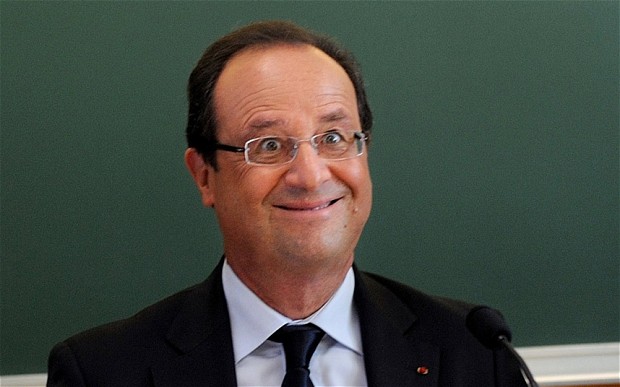 French news agency AFP has been caught up in a self-censorship row after attempting to retract a photo of President Francois Hollande flashing a gormless smile. The whole debacle has gone viral, forcing AFP to make a statement denying they had caved to government pressure. Rather, they cited internal editorial guidelines ‘not to transmit images that gratuitously ridicule people.’ However, politicians are not strangers to banning (or trying to ban!) images that makes them look a bit silly.
French news agency AFP has been caught up in a self-censorship row after attempting to retract a photo of President Francois Hollande flashing a gormless smile. The whole debacle has gone viral, forcing AFP to make a statement denying they had caved to government pressure. Rather, they cited internal editorial guidelines ‘not to transmit images that gratuitously ridicule people.’ However, politicians are not strangers to banning (or trying to ban!) images that makes them look a bit silly.
 You’d think that Vladimir Putin, used to being in the public eye, captured in completely random and non-staged situations like this, wouldn’t mind being the inspiration for some fine art. That turned out not to be the case when a St Petersburg gallery exhibited a painting of Putin and PM Dmitry Medvedev – the former sporting a fetching pink negligee, the latter a black lace push-up bra. Russian police raised the gallery and removed the picture in question, as well as three others depicting Russian political leaders. The reason given was that the imagines ‘violate existing legislation’.
You’d think that Vladimir Putin, used to being in the public eye, captured in completely random and non-staged situations like this, wouldn’t mind being the inspiration for some fine art. That turned out not to be the case when a St Petersburg gallery exhibited a painting of Putin and PM Dmitry Medvedev – the former sporting a fetching pink negligee, the latter a black lace push-up bra. Russian police raised the gallery and removed the picture in question, as well as three others depicting Russian political leaders. The reason given was that the imagines ‘violate existing legislation’.
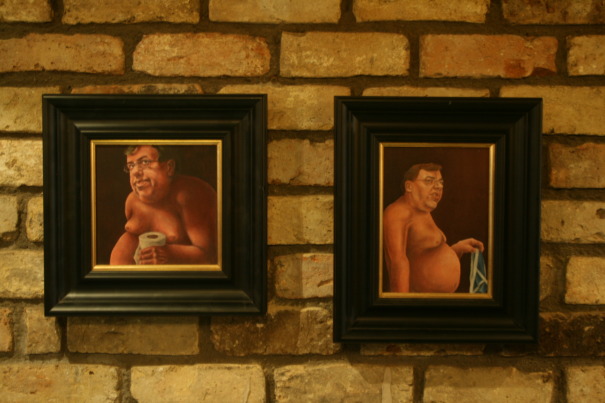 Back in 2009, artist Conor Casby painted two pictures of former Irish taoiseach Brian Cowen sitting on a toilet naked. He then hung them on the walls of the National Gallery and the Royal Hibernian Gallery in Dublin, and broadcaster RTE made a short piece about it. The outcome? RTE had to issue a formal apology and remove the item from its online archive. Meanwhile, the police launched a country wide manhunt for Casby. He had to hand over five more paintings to the police and faced potential charges of indecency, criminal damage and incitement to hatred. All for making a politician the butt of his joke.
Back in 2009, artist Conor Casby painted two pictures of former Irish taoiseach Brian Cowen sitting on a toilet naked. He then hung them on the walls of the National Gallery and the Royal Hibernian Gallery in Dublin, and broadcaster RTE made a short piece about it. The outcome? RTE had to issue a formal apology and remove the item from its online archive. Meanwhile, the police launched a country wide manhunt for Casby. He had to hand over five more paintings to the police and faced potential charges of indecency, criminal damage and incitement to hatred. All for making a politician the butt of his joke.
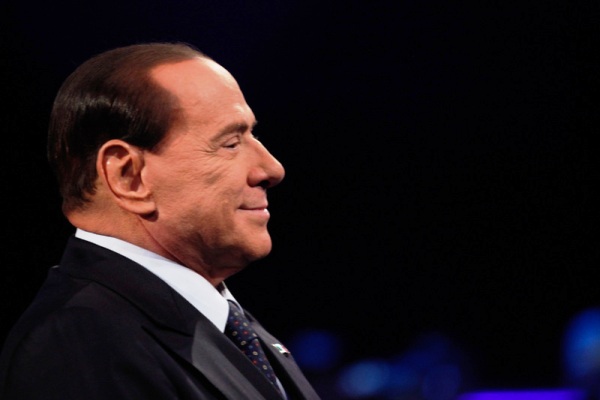 In 2002, former Italian Prime Minister Silvio Berlusconi was accused of censoring a play putting him and his compatriots in an unfavorable light. Renowned theatre director Luca Ronconi used caricature pictures of Berlusconi and two other ministers as props in his production of Greek comedy “The Frogs.” Ronconi said officials from ruling party Forza Italia tried to make him remove the pictures from stage. Berlusconi, on the other hand, stated that while the pictures ‘didn’t please him’: ‘The government, the whole government, doesn’t even know what censorship is.’
In 2002, former Italian Prime Minister Silvio Berlusconi was accused of censoring a play putting him and his compatriots in an unfavorable light. Renowned theatre director Luca Ronconi used caricature pictures of Berlusconi and two other ministers as props in his production of Greek comedy “The Frogs.” Ronconi said officials from ruling party Forza Italia tried to make him remove the pictures from stage. Berlusconi, on the other hand, stated that while the pictures ‘didn’t please him’: ‘The government, the whole government, doesn’t even know what censorship is.’
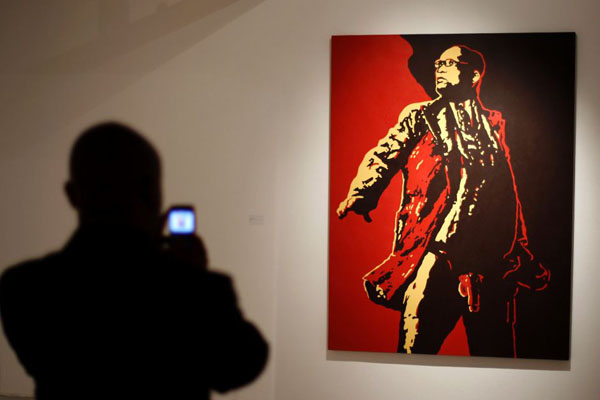 South African President Jacob Zuma caused quite a stir when he demanded that a painting of him be removed from Johannesburg’s Goodman Gallery. ‘The Spear’ was in the style of portraits of revolutionary leaders, but for small fact that his, um, spear, was hanging out. He also wanted City Press newspaper to remove a photo of it from their website. When both refused, Zuma’s party the ANC declared they would take the gallery to High Court and called for a boycott of City Press. Finally, a couple of ANC supporters were caught on tape defacing the painting. Taking the matter of The Spear into their own hands, some might say (sorry).
South African President Jacob Zuma caused quite a stir when he demanded that a painting of him be removed from Johannesburg’s Goodman Gallery. ‘The Spear’ was in the style of portraits of revolutionary leaders, but for small fact that his, um, spear, was hanging out. He also wanted City Press newspaper to remove a photo of it from their website. When both refused, Zuma’s party the ANC declared they would take the gallery to High Court and called for a boycott of City Press. Finally, a couple of ANC supporters were caught on tape defacing the painting. Taking the matter of The Spear into their own hands, some might say (sorry).
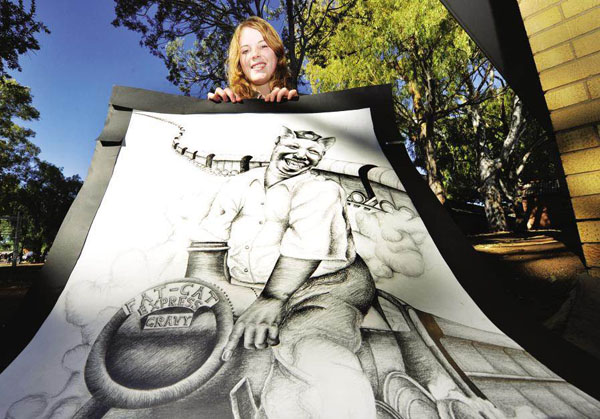 At least it seems the future leadership of the ANC is getting some training in dealing with awkward art-related stories of their own. Bloemfontein student Alta Bonnet (17) was told her painting depicting former ANC Youth leader Julius Malema ‘as a fat cat on a gravy train’ might not be exhibited at a city art show. The picture was deemed ‘too political’.
At least it seems the future leadership of the ANC is getting some training in dealing with awkward art-related stories of their own. Bloemfontein student Alta Bonnet (17) was told her painting depicting former ANC Youth leader Julius Malema ‘as a fat cat on a gravy train’ might not be exhibited at a city art show. The picture was deemed ‘too political’.
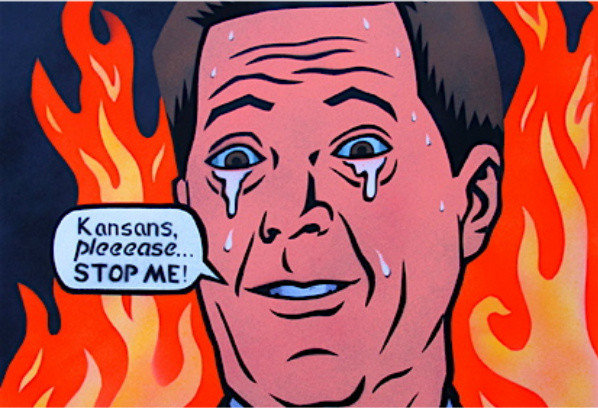 Kansas artist Dave Loewenstein last year had his picture of Governor Sam Brownback removed from a cafe in the state’s capital Topeka. The picture is a cartoon depiction of the governor, with the words ‘REJECT BROWNBACK’ printed on. Loewenstein said the picture was in protest at Brownback’s policies and not him personally. Greg Ready, the landlord of the building, said they had chosen to remove the painting because Brownback’s daughter worked at the cafe in question, adding ‘there was no political motivation for this action whatsoever.’
Kansas artist Dave Loewenstein last year had his picture of Governor Sam Brownback removed from a cafe in the state’s capital Topeka. The picture is a cartoon depiction of the governor, with the words ‘REJECT BROWNBACK’ printed on. Loewenstein said the picture was in protest at Brownback’s policies and not him personally. Greg Ready, the landlord of the building, said they had chosen to remove the painting because Brownback’s daughter worked at the cafe in question, adding ‘there was no political motivation for this action whatsoever.’
But you could understand Brownback being a little thin skinned – this wasn’t the first time he had been viciously attacked. In 2011, when his office took note of a tweet by High School student Emma Sullivan (18), her principal demanded she write an apology letter to the governor. The tweet? “Just made mean comments at gov. brownback and told him he sucked, in person (hash)heblowsalot.” Scathing.
Have we missed any? Let us know in the comments!
27 Aug 2013 | Index Reports, Mexico, News and features
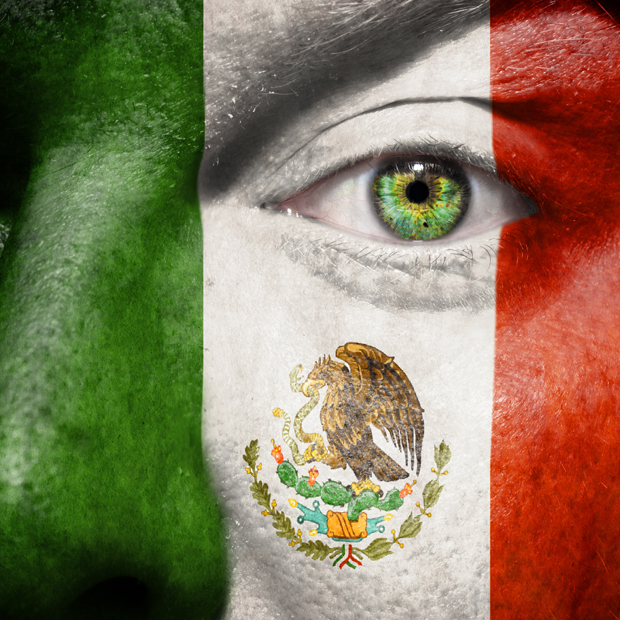
(Photo illustration: Shutterstock)
Mexico was transformed in 2000, when the National Action Party, PAN, was elected to power, ending a 70 year control by the Institutionally Revolutionary Party, PRI.
During the PRI years, self censorship was rampant in the country, as the government imposed a heavy handed control of the national media. PAN candidates ruled for the next 12 years, from 2000 to 2012. But the PRI returned to power last December, due to electorate fatigue with former President Felipe Calderon’s war on drugs.
The country has faced increasing challenges from organized crime gangs that were targeted during the Calderon government and it has had serious impacts on press freedoms in the Mexican provinces, where most media recoiled from reporting on organized crime-related violence.
In the move to control organized crime groups, the Mexican government has increased its surveillance capacity. It has also engaged in human rights violations, which according to international organizations, such as Human Rights Watch, have only exacerbated the security situation.
There is little media regulation and zero artistic censorship. But in the name of protecting the state from organized crime, the government has introduced various edicts and laws that could affect the rights of citizens.
In March 2012, the Mexican Congress approved new legislation that gave police more access to online information. Also between 2011 and 2012, the Secretariat of National Defense, which controls the Mexican Armed Forces, purchased advanced domestic surveillance equipment. The new equipment includes mobile phone and online communications software that can be openly used to monitor Mexican citizens.
In 2012, the government of the State of Veracruz introduced a public nuisance law that sends to jail any social media member who uses Twitter or Facebook to warn fellow citizens about violence. The law was set in place because two Twitter users warned state residents of shootouts that turned out to be false alarms, but had the city of Veracruz traumatized by the alleged reports. The problem remains that bloggers, and social media users have become alternative sources of information because the traditional media in at least half of the territory of Mexico are afraid of reporting on drug related violence.
Drug traffickers also retaliated against social media users. They killed at least two bloggers in the northern state of Taumalipas and also two Twitter users, whose bodies were never identified and were found hanging from a bridge overpass. Two websites that made a name for themselves by running stories and reports on drug trafficking activities around the country were forced to shut down because of direct attacks.
Twitter, Facebook and YouTube have been extremely useful sources of information in Mexico. Abuses of authority against indigenous people or by children of the powerful and well-connected have been exposed in videos that turn viral in the web and have helped to right wrongs that would have gone unnoticed otherwise.
Several laws have been passed that are supposed to help people affected by the war on drugs. There is a General Victims law that was approved by Congress by which is still not implemented. Similarly, Congress approved a federal protection mechanism for human rights defenders and journalists, but the law has been criticized by freedom of the press organizations, as having few resources and focus.
Mexico declared federal defamation laws illegal in 2007, however, about a dozen states still have those on the books. At the federal level, a person can still sue an author for moral damage. At least two critical book writers, who have written books accusing government officials of corruption, have been hit with lawsuits in the last two years.
Media ownership remains potent in Mexico. Several dozen national newspapers are published daily, and many more digital news outlets have opened in the last two years.
What was not opened until June 2013 was broadcast media. Only two news outlets were for long able to transmit television signals nationally through open television channels. They were Televisa and Television Azteca, which are owned by two of Mexico’s wealthiest citizens. However, with a new Telecommunications law that was approved by Congress in June 2013, Mexico will be able to have two more open signal channels. Another wealthy Mexican, Carlos Slim, who owns an internet-based television network called Uno Noticias will probably benefit from the new law. The new legislation will also promote the installation of a broadband Internet network nationwide.
There are 41 million Mexicans who use the internet, according to the Mexican Association of Internet. The states with the highest number of internet users are in Mexico City, State of Mexico and State of Jalisco. The average daily use of the web ranges from four hours to nine minutes. More than 90 percent of all Mexicans using the internet also use social media.
Artistic Freedom
Artists have enjoyed unprecedented freedom to be creative in Mexico. The only problem lies with the commercial theatre network, which tends to not keep Mexican made movies long enough in exhibition. One movie that is critical of the legal system in Mexico City and the tradition by local police of grabbing innocent people and accusing them of murder and other crimes, Presumed Guilty, has faced serious challenges because of what appears to be an alleged concerted campaign by a Mexico City legal group that has stopped the film from showing in the country because of multiple lawsuits brought on by people who are shown on the film, and who never signed an agreement to appear in the movie.
This article was originally published on 27 Aug, 2013 at indexoncensorship.org






 In 2002,
In 2002, 


